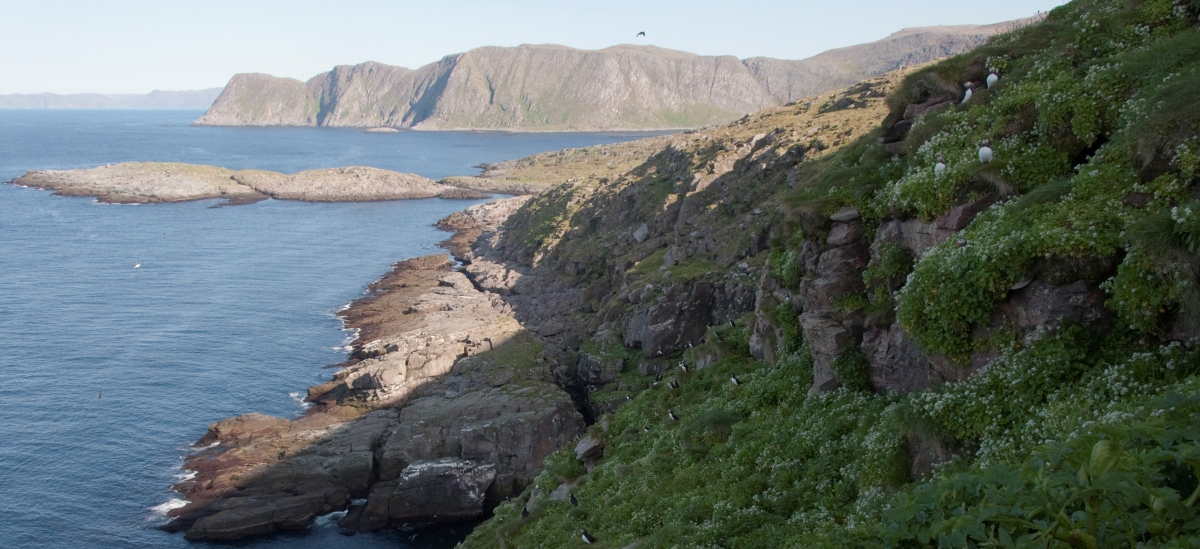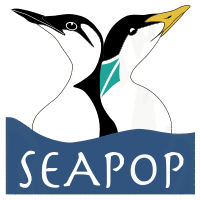Key site Hjelmsøya
Hjelmsøya is in the north of the country, where the coastline turns eastwards and the sea is to the north and not to the west. Here, the shelf break leaves the coast, and the shallow Barents Sea extends northwards towards Bjørnøya and eastwards towards Novaja Zemlja. Cod fry, herring and saithe drift past the island from the south and into the Barents Sea – a resource taken advantage of by the seabirds. The seabirds on Hjelmsøya have been monitored since 1984. Contact person: Geir Helge Systad, NINA

Location and description
Hjelmsøya (71° 06′ N, 24° 44′ E) is seaward of the municipality centre Havøysund, between Ingøya and Fruholmen to the west and Magerøya with Nordkapp to the east. The actual bird cliff is called Staurfjellet and is on a peninsula on the north coast of Hjelmsøya, with steep cliffs in the north, and steep slopes towards Akkarfjorden in the west and Tarevika in the east. Hjelmsøystauren is centrally located in the cliff, a steep 80-90 meter high stack. In the days of old, local egg collectors climbed up here on 17 May to raise the flag. The puffins, which now dominate Staurfjellet, nest from Krykkjesjåen in the west to Finnkonneset in the east, in lush grassy slopes. Staurfjellet also houses a large guillemot colony (12-14,000 pairs in 2014), but this species has been in steep decline since the 1970s. Between Tarevika and Akkarfjorden lies Staurfjell plateau. Staurfjellet is protected as a nature reserve.
The research station is located in Keila east of the bird cliff, in the site of an old settlement with a sheltered harbour that was burned and vacated during World War II. Here lived about 70 residents at the most, but numbers increased greatly during the spring cod fishing. East of Keila lies Kirkneset and Kirknesholmen with old houses and roads that are becoming increasingly difficult to see.
Nobody lives permanently on Hjelmsøya anymore, but most of the houses built after the war on the east side of the island still stand and are used in summer. There are also some cabins built in the old settlement sites. The fishing village of Sandvikvær in Akkarfjorden, west of the bird mountain, is falling into ruin, and most of the houses have fallen down. Sandvikvær was abandoned in the late 1960s after the owner went bankrupt.
The key site Hjelmsøya includes Staurfjellet, where most of the work is done, Gjesværstappan in Nordkapp municipality, where the populations of gannets and puffins are monitored, Lille Kamøy in Hammerfest municipality, where shags are counted, and a number of colonies throughout West Finnmark where cormorants are counted.
Access
It is not easy to get to Hjelmsøya. The nearest airports are Hammerfest, Lakselv and Honningsvåg, but Alta is also within reasonable reach. From Hammerfest or Honningsvåg you can take the coastal ferry to Havøysund, and from Hammerfest, Alta and Lakselv there is a bus to the same location. The road to Havøysund is the national tourist route. In Havøysund there is a hotel with fishermen’s cabins, and there are other options that focus on tourist fishing. There is no public transport out to Hjelmsøya from Havøysund. Travelling by small boat, it takes 1-2 hours to reach the bird cliff, which is very exposed to the open sea.
Wildlife
Hjelmsøya used to house the biggest common guillemot Uria aalge colony in Norway, with more than 120 000 pairs counted by Einar Brun from Tromsø Museum in the late 1970s. Since that time, the colony has been reduced by 90%. The reasons for the collapse are many, but disturbance and bycatch in fishing gear were important causes for a long time. The guillemots on Hjelmsøya are now thriving and the population is growing among those that breed hidden from disturbance by the white-tailed eagle Haliaeetus albicilla. There used to be large numbers of Brünnich’s guillemots Uria lomvia in the colony, with more than 1,500 pairs in the late 1980s, but this species only breeds on open shelves and has thus not been able to protect itself against white-tailed eagles. They have not produced chicks in Staurfjellet since the early 1990s. The black-legged kittiwake Rissa tridactyla previously bred in large numbers, and the colony counted more than 40 000 pairs at most. In 2014, there were fewer than 2 000 pairs left and the species is on the verge of extinction on the cliff. Most numerous is the puffin Fratercula arctica, with more than 80 000 pairs at Staurfjellet. They breed in lush grassy pastures and hanging gardens of scurvey grass between Krykkjesjåen in the west and Finnkonneset in the east.
Other seabirds that breed on Hjelmsøya are the common gull Larus canus, arctic skua Stercorarius parasiticus, great skua S. skua, herring gull Larus argentatus, great black-backed gull L. marinus, cormorant Phalacrocorax carbo, shag P. aristotelis, common eider Somateria mollisima, greylag goose Anser anser and black guillemot Cepphus grylle. In the spring one can see tens of white-billed divers Gavia adamsii moving eastwards, and other eastern species such as the red-throated pipit Anthus cervinus, little stint Calidris minuta and king eiders Somateria spectabilis are often seen. Hjelmsøya is otherwise one of the northernmost breeding sites in the world for the lapwing Vanellus vanellus, curlew Numenius arquata and skylark Alauda arvensis.
Mink Neovison vison have occasionally been a major problem in the bird cliff, taking both adult birds up to the size of guillemots and razorbills and chicks of many species. Hundreds of mink have been trapped since 2005. The species experienced a sharp upturn after a lemming Lemmus lemmus year in 2007, resulting in an escalation of the predation on puffins and herring gulls the following season. Otters Lutra lutra also live near the bird cliff, and have a permanent den near the station. They use much the same areas as the mink, but comprise a minor problem as a predator. Nevertheless, we have encountered otters carrying puffin chicks, and especially late in the season there is a network of otter tracks in the terrain. Grey seals Halichoerus grypus are seen below the cliff throughout the year, and they breed near the field station. Harbour seals Phoca vitulina, humpback whales Megaptera novaeangliae, minke whales Balaenoptera acutorostrata, harbour porpoises Phocoena phocoena, belugas Delphinapterus leucas, killer whales Orcinus orca, Atlantic white-sided dolphin Lagenorhynchus acutus and white-beaked dolphin Lagenorhynchus albirostris occur more or less frequently near the shore.
Human activity
Nobody lives permanently on Hjelmsøya anymore, but many living in Havøysund have a weekend cottage or house there. Hjelmsøybanken and Nordkappgrunnen are famous fishing grounds where there is a lot of activity in spring and summer. Since 2000, fishing tourism has exploded in Finnmark, and tourists, especially foreigners, in rented boats are often seen below the cliffs. Bird tourism has not developed on Hjelmsøya, in contrast to Gjesvær and Gjesværstappan, where activity is very high, with several operators, accommodation possibilities and boats that take people around the bird cliffs.
Fieldwork
The first to carry out systematic field work in Staurfjellet was the teacher Kjell Vorum, who ran a ringing scheme of seabirds on behalf of Stavanger Museum in 1949 and 1950. He fell and died when working in the cliffs in 1950. After this, Einar Brun from Tromsø Museum visited the cliff in the early 1960s, and in 1969, he estimated that 120 000 pairs of common guillemots bred on Hjelmsøya. Brun also visited Staurfjellet in the 1970s and documented a steep decline in guillemot numbers.
Regular monitoring of seabirds on Hjelmsøya was started in 1984, and in 1985, a hut was flown out from Havøysund to Keila. The first guillemot plots were defined in 1984 and kittiwake plots in 1991. Little was done beyond population counts until 2004. Some birds were ringed, especially in the 1980s, and birds from this time are still caught.
Svein Mathiesen from Havøysund wardened at the reserve, and was long the local contact person for Tromsø Museum and the Norwegian Institute for Nature Research. He has contributed with knowledge and logistics that have been invaluable to the researchers from Tromsø.
Since SEAPOP was launched in 2004, activity on Hjelmsøya has multiplied, with people working from early May to mid-August. A new field station was established in 2006 with room for at least six field workers. We now monitor around 20 different species on Hjelmsøya and the islands around, of which 14 species are key species in SEAPOP. Most of the species are monitored on Staurfjellet on Hjelmsøya, but gannets and puffins are monitored at Gjesværstappan (71° 08′ 26 “N, 25° 20′ 11” E), shags at Lille Kamøy (70° 51′ 08 “N, 23° 03′ 47 “E) and cormorants on several colonies in West Finnmark. The work is coordinated by NINA and has its main base at the institute field station in Keila (71° 06 ’34” N, 24° 44′ 41” E).
The field season starts in early May with a check of colour-ringed kittiwakes as well as monitoring counts of black guillemots and eiders. The station is then normally manned from the beginning of June to mid-August, with a break in late July/early August. There are always two people present at the station for safety reasons, but up to six people may be at work during the busiest periods.




